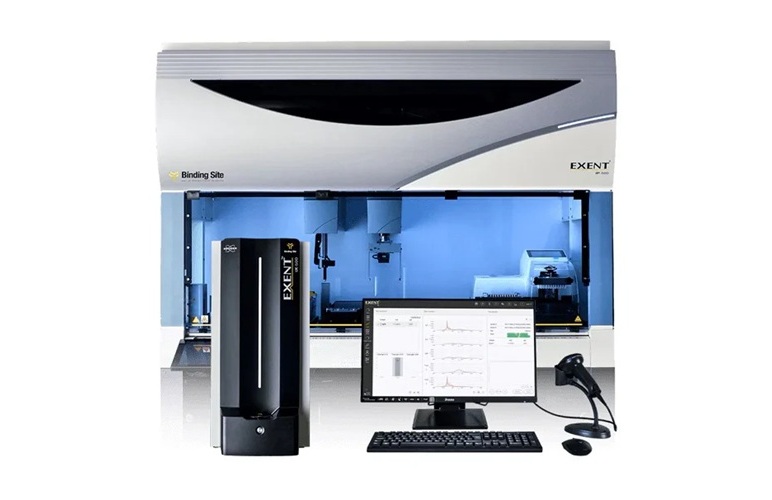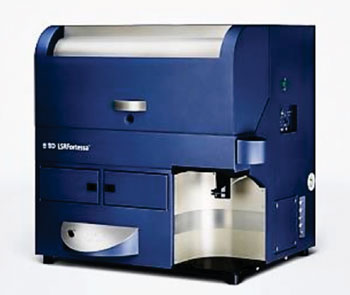Cell Marker Enables Pathogenic Infection Prognosis
|
By LabMedica International staff writers Posted on 14 Oct 2015 |
When a pathogen invades the body, specific cells in the human immune system are ready to take immediate action in order to destroy it, but the molecular characteristics of these killer cells were unknown until recently.
In some patients, viral infections such as Hepatitis B (HBV) can become chronic as a certain amount of the virus remains permanently in the body, however the immune system cannot control the infection and the disease is not completely cured.
A large team of scientists led by those at Technical University of Munich (Germany) obtained peripheral blood mononuclear cells (PBMCs) from patients chronically infected with HBV, hepatitis C (HCV), and healthy donors visiting an outpatient clinic. The team used a variety of techniques to create a molecular profile of the protective cells. By studying these immune cells from patients' blood, they were able to predict the course of infections.
Flow cytometric analyses and assessment of mean fluorescence intensity were conducted with a LSR Fortessa (BD Biosciences; San Jose, CA, USA). Total ribonucleic acid (RNA) was extracted with QIAzol Lysis Reagent (Qiagen; Hilden, Germany) and then purified using the Qiagen miRNeasy Mini Kit. The RNA integrity (RNA Integrity Score equal to or greater than 6.8) and quantity were determined on the 2100 Bioanalyzer (Agilent Technologies; Santa Clara, CA, USA). Peptides were separated on an EASY-nLC 1000 HPLC system (Thermo Fisher Scientific; Waltham, MA, USA) coupled online to the Thermo Fisher Scientific Q Exactive mass spectrometer via a nanoelectrospray source.
The investigators found that the fractalkine-receptor/CX3CR1 distinguishes memory CD8+ T cells with cytotoxic effector function from those with proliferative capacity, independent of tissue-homing properties. CX3CR1-based transcriptome and proteome-profiling defined a core signature of memory CD8+ T cells with effector function. They found CD62LhiCX3CR1+ memory T cells that reside within lymph nodes. This population showed distinct migration patterns and positioning in proximity to pathogen entry sites. Virus-specific CX3CR1+ memory CD8+ T cells were scarce during chronic infection in humans but increased when infection was controlled spontaneously or by therapeutic intervention.
Percy A. Knolle, MD, a professor and lead author of the study, said, “Assessing a patient's ability to control an infection has always been a protracted process, because there were no markers to reliably label killer cells, the real 'task force' of the immune system, yet this type of prediction is extremely important for selecting a suitable course of treatment. The new marker will make predictions about the course of infections much faster and more precise. All we need to do is take blood from the patient and identify the number of killer cells using the new marker.” The study was published on September 25, 2015, in the journal Nature Communications.
Related Links:
Technical University of Munich
BD Biosciences
Qiagen
In some patients, viral infections such as Hepatitis B (HBV) can become chronic as a certain amount of the virus remains permanently in the body, however the immune system cannot control the infection and the disease is not completely cured.
A large team of scientists led by those at Technical University of Munich (Germany) obtained peripheral blood mononuclear cells (PBMCs) from patients chronically infected with HBV, hepatitis C (HCV), and healthy donors visiting an outpatient clinic. The team used a variety of techniques to create a molecular profile of the protective cells. By studying these immune cells from patients' blood, they were able to predict the course of infections.
Flow cytometric analyses and assessment of mean fluorescence intensity were conducted with a LSR Fortessa (BD Biosciences; San Jose, CA, USA). Total ribonucleic acid (RNA) was extracted with QIAzol Lysis Reagent (Qiagen; Hilden, Germany) and then purified using the Qiagen miRNeasy Mini Kit. The RNA integrity (RNA Integrity Score equal to or greater than 6.8) and quantity were determined on the 2100 Bioanalyzer (Agilent Technologies; Santa Clara, CA, USA). Peptides were separated on an EASY-nLC 1000 HPLC system (Thermo Fisher Scientific; Waltham, MA, USA) coupled online to the Thermo Fisher Scientific Q Exactive mass spectrometer via a nanoelectrospray source.
The investigators found that the fractalkine-receptor/CX3CR1 distinguishes memory CD8+ T cells with cytotoxic effector function from those with proliferative capacity, independent of tissue-homing properties. CX3CR1-based transcriptome and proteome-profiling defined a core signature of memory CD8+ T cells with effector function. They found CD62LhiCX3CR1+ memory T cells that reside within lymph nodes. This population showed distinct migration patterns and positioning in proximity to pathogen entry sites. Virus-specific CX3CR1+ memory CD8+ T cells were scarce during chronic infection in humans but increased when infection was controlled spontaneously or by therapeutic intervention.
Percy A. Knolle, MD, a professor and lead author of the study, said, “Assessing a patient's ability to control an infection has always been a protracted process, because there were no markers to reliably label killer cells, the real 'task force' of the immune system, yet this type of prediction is extremely important for selecting a suitable course of treatment. The new marker will make predictions about the course of infections much faster and more precise. All we need to do is take blood from the patient and identify the number of killer cells using the new marker.” The study was published on September 25, 2015, in the journal Nature Communications.
Related Links:
Technical University of Munich
BD Biosciences
Qiagen
Read the full article by registering today, it's FREE! 

Register now for FREE to LabMedica.com and get access to news and events that shape the world of Clinical Laboratory Medicine. 
- Free digital version edition of LabMedica International sent by email on regular basis
- Free print version of LabMedica International magazine (available only outside USA and Canada).
- Free and unlimited access to back issues of LabMedica International in digital format
- Free LabMedica International Newsletter sent every week containing the latest news
- Free breaking news sent via email
- Free access to Events Calendar
- Free access to LinkXpress new product services
- REGISTRATION IS FREE AND EASY!
Sign in: Registered website members
Sign in: Registered magazine subscribers
Latest Immunology News
- Gene Signature Test Predicts Response to Key Breast Cancer Treatment
- Chip Captures Cancer Cells from Blood to Help Select Right Breast Cancer Treatment
- Blood-Based Liquid Biopsy Model Analyzes Immunotherapy Effectiveness
- Signature Genes Predict T-Cell Expansion in Cancer Immunotherapy
- Molecular Microscope Diagnostic System Assesses Lung Transplant Rejection
- Blood Test Tracks Treatment Resistance in High-Grade Serous Ovarian Cancer
- Luminescent Probe Measures Immune Cell Activity in Real Time
- Blood-Based Immune Cell Signatures Could Guide Treatment Decisions for Critically Ill Patients
- Novel Tool Predicts Most Effective Multiple Sclerosis Medication for Patients
- Companion Diagnostic Test for CRC Patients Identifies Eligible Treatment Population
- Novel Tool Uses Deep Learning for Precision Cancer Therapy
- Companion Diagnostic Test Identifies HER2-Ultralow Breast Cancer and Biliary Tract Cancer Patients
- Novel Multiplex Assay Supports Diagnosis of Autoimmune Vasculitis
- Blood Test Predicts Immunotherapy Efficacy in Triple-Negative Breast Cancer
- Simple Genetic Testing Could Predict Treatment Success in Multiple Sclerosis Patients
- Novel Gene Signature Predicts Immunotherapy Response in Advanced Kidney Cancers
Channels
Clinical Chemistry
view channel
Chemical Imaging Probe Could Track and Treat Prostate Cancer
Prostate cancer remains a leading cause of illness and death among men, with many patients eventually developing resistance to standard hormone-blocking therapies. These drugs often lose effectiveness... Read more
Mismatch Between Two Common Kidney Function Tests Indicates Serious Health Problems
Creatinine has long been the standard for measuring kidney filtration, while cystatin C — a protein produced by all human cells — has been recommended as a complementary marker because it is influenced... Read moreMolecular Diagnostics
view channel
First-Of-Its-Kind Automated System Speeds Myeloma Diagnosis
More than 176,000 people are diagnosed with multiple myeloma worldwide each year, yet the current diagnostic pathway can be slow and uncertain, often relying on a highly subjective interpretation of test results.... Read more
Blood Protein Profiles Predict Mortality Risk for Earlier Medical Intervention
Elevated levels of specific proteins in the blood can signal increased risk of mortality, according to new evidence showing that five proteins involved in cancer, inflammation, and cell regulation strongly... Read moreHematology
view channel
Platelet Activity Blood Test in Middle Age Could Identify Early Alzheimer’s Risk
Early detection of Alzheimer’s disease remains one of the biggest unmet needs in neurology, particularly because the biological changes underlying the disorder begin decades before memory symptoms appear.... Read more
Microvesicles Measurement Could Detect Vascular Injury in Sickle Cell Disease Patients
Assessing disease severity in sickle cell disease (SCD) remains challenging, especially when trying to predict hemolysis, vascular injury, and risk of complications such as vaso-occlusive crises.... Read more
ADLM’s New Coagulation Testing Guidance to Improve Care for Patients on Blood Thinners
Direct oral anticoagulants (DOACs) are one of the most common types of blood thinners. Patients take them to prevent a host of complications that could arise from blood clotting, including stroke, deep... Read moreMicrobiology
view channel
Rapid Assay Identifies Bloodstream Infection Pathogens Directly from Patient Samples
Bloodstream infections in sepsis progress quickly and demand rapid, precise diagnosis. Current blood-culture methods often take one to five days to identify the pathogen, leaving clinicians to treat blindly... Read more
Blood-Based Molecular Signatures to Enable Rapid EPTB Diagnosis
Extrapulmonary tuberculosis (EPTB) remains difficult to diagnose and treat because it spreads beyond the lungs and lacks easily accessible biomarkers. Despite TB infecting 10 million people yearly, the... Read more
15-Minute Blood Test Diagnoses Life-Threatening Infections in Children
Distinguishing minor childhood illnesses from potentially life-threatening infections such as sepsis or meningitis remains a major challenge in emergency care. Traditional tests can take hours, leaving... Read more
High-Throughput Enteric Panels Detect Multiple GI Bacterial Infections from Single Stool Swab Sample
Gastrointestinal (GI) infections are among the most common causes of illness worldwide, leading to over 1.7 million deaths annually and placing a heavy burden on healthcare systems. Conventional diagnostic... Read morePathology
view channel
AI Tool Outperforms Doctors in Spotting Blood Cell Abnormalities
Diagnosing blood disorders depends on recognizing subtle abnormalities in cell size, shape, and structure, yet this process is slow, subjective, and requires years of expert training. Even specialists... Read more
AI Tool Rapidly Analyzes Complex Cancer Images for Personalized Treatment
Complex digital biopsy images that typically take an expert pathologist up to 20 minutes to assess can now be analyzed in about one minute using a new artificial intelligence (AI) tool. The technology... Read moreTechnology
view channel
AI Saliva Sensor Enables Early Detection of Head and Neck Cancer
Early detection of head and neck cancer remains difficult because the disease produces few or no symptoms in its earliest stages, and lesions often lie deep within the head or neck, where biopsy or endoscopy... Read more
AI-Powered Biosensor Technology to Enable Breath Test for Lung Cancer Detection
Detecting lung cancer early remains one of the biggest challenges in oncology, largely because current tools are invasive, expensive, or unable to identify the disease in its earliest phases.... Read moreIndustry
view channel
Abbott Acquires Cancer-Screening Company Exact Sciences
Abbott (Abbott Park, IL, USA) has entered into a definitive agreement to acquire Exact Sciences (Madison, WI, USA), enabling it to enter and lead in fast-growing cancer diagnostics segments.... Read more






 assay.jpg)

















